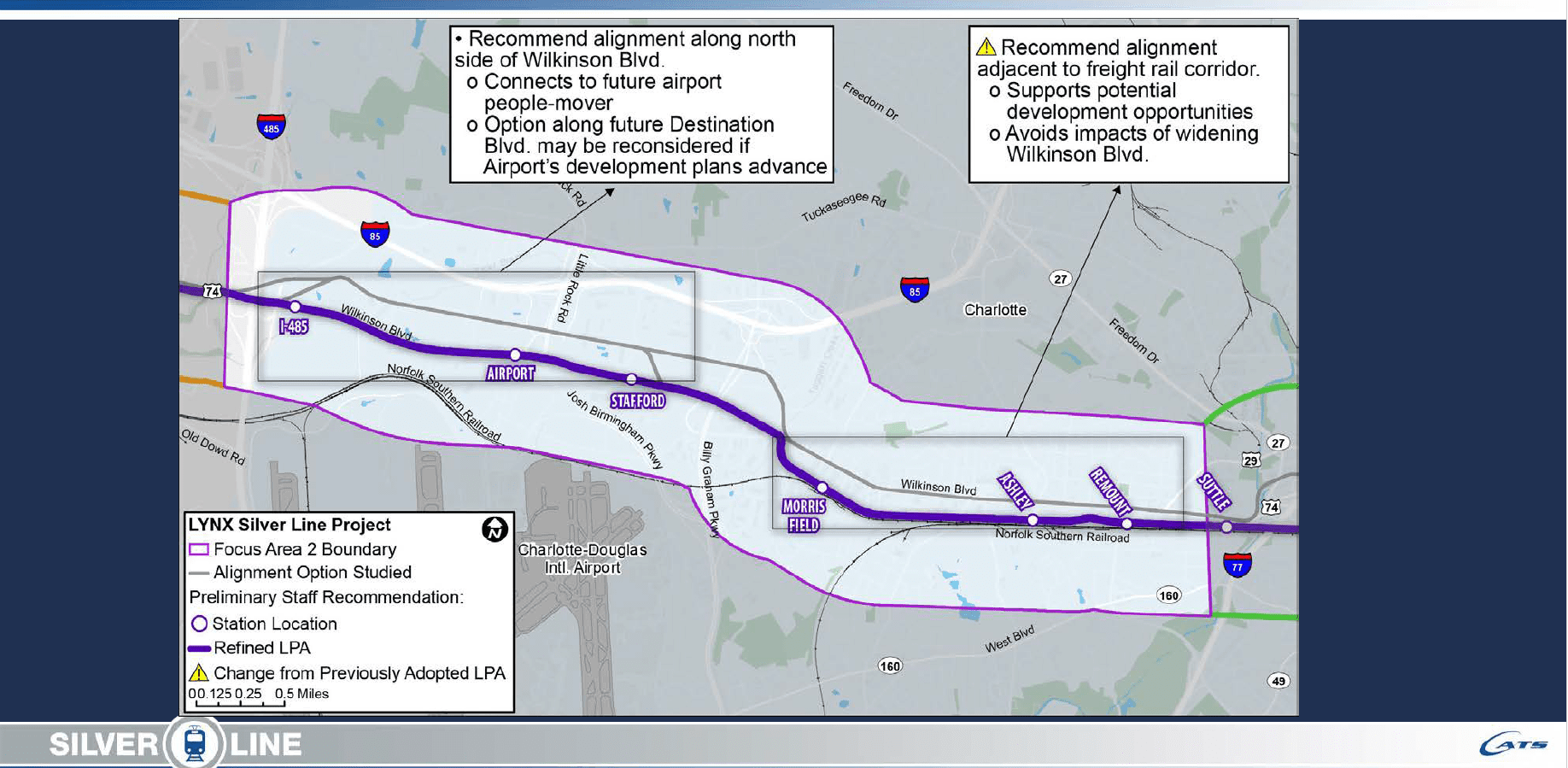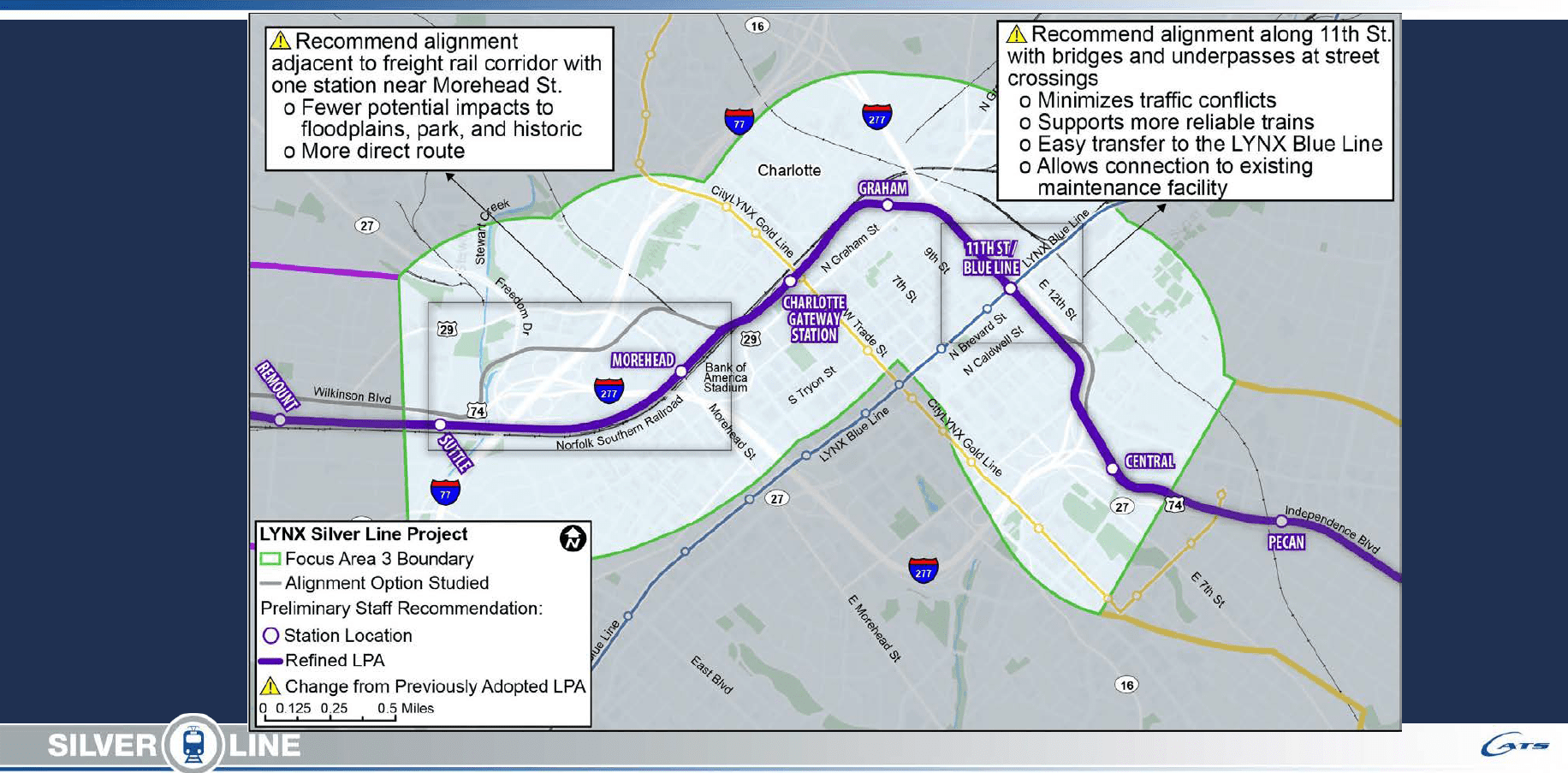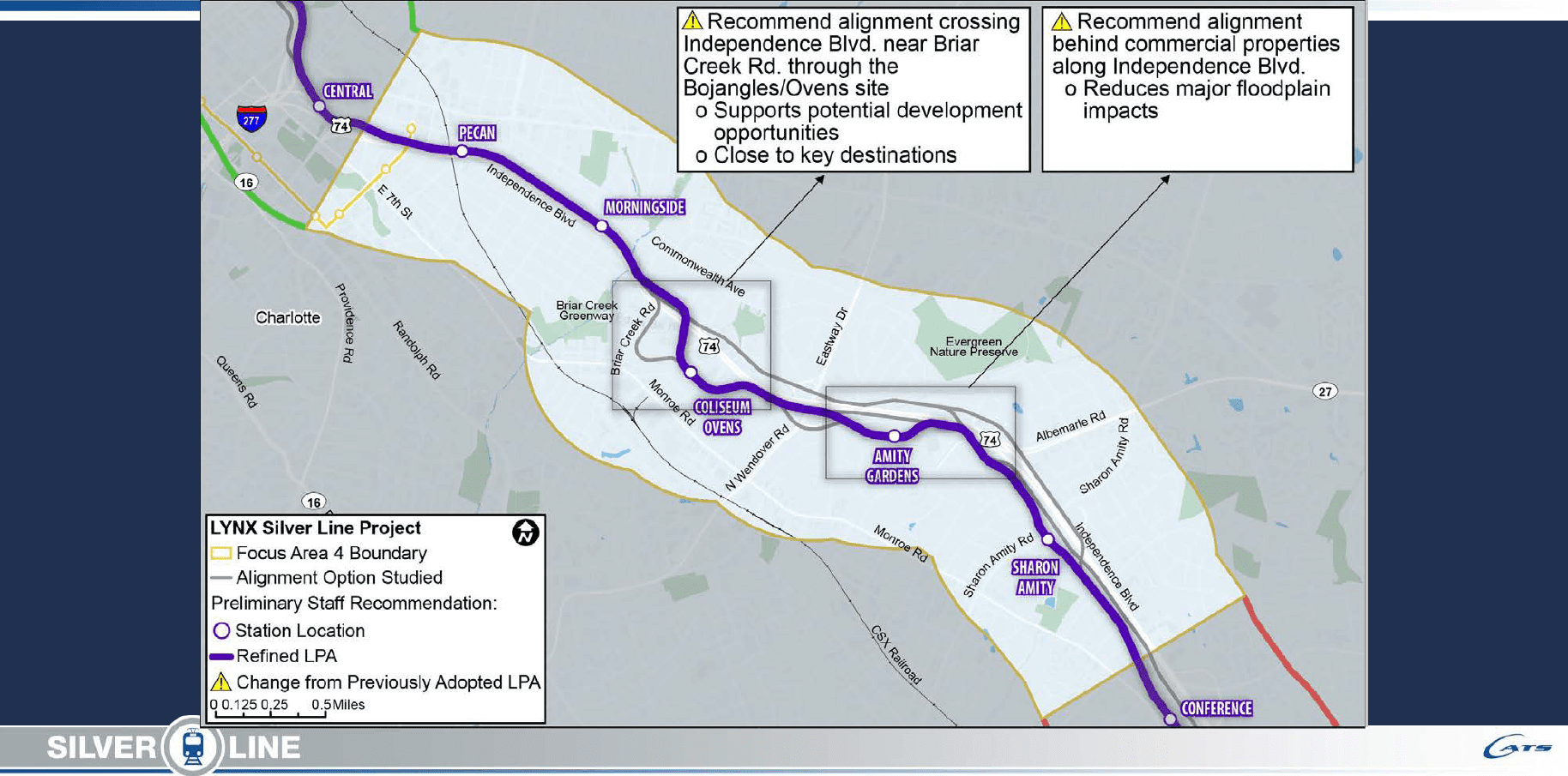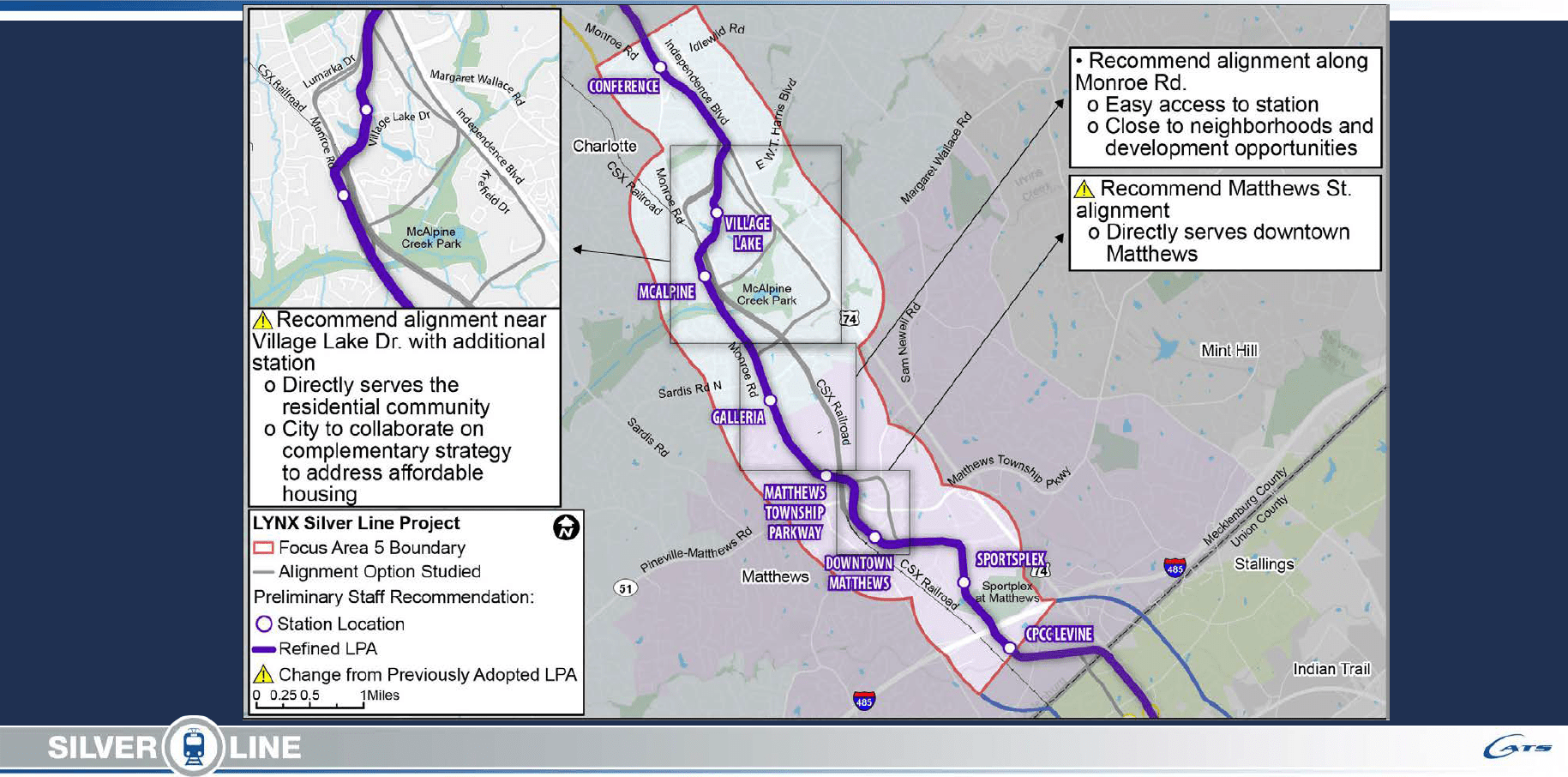Plans for the Silver Line are taking shape

The multibillion dollar Silver Line light rail is years away, but Charlotte is moving closer to a final vision for the east-west transit line that could reshape much of Charlotte.
This week, the Charlotte Area Transit System presented a more detailed map of the proposed routes and stops. It’s an ambitious undertaking: At roughly 26 miles, the Silver Line would be nearly twice as long as either segment of the Blue Line, and could stretch into Union and Gaston counties.
There are still plenty of hurdles to overcome, and the rail line is likely a decade or more away. In addition to detailed planning, the city has to figure out how to pay for it. A proposed 1-cent sales tax needs legislative, county and voter approval, as well as state and federal funding.
Mayor Pro Tem Julie Eiselt asked Charlotte Area Transit System CEO John Lewis what the plan is if the city can’t fund the whole proposal immediately.
“What happens if we only get half — best case we even get anything — but we only get half of what we need?” she said.
“We could begin with uptown to the airport first, or Matthews to uptown first,” said Lewis. “We can certainly work to create a project that can be delivered based on the amount of funding available.”
Still, work is moving forward. Council members got a peek at proposed routes for several of the Silver Line’s main segments: West to Charlotte Douglas International Airport, through uptown and southeast towards Union County. Here are some of the main points for each, as well as some outstanding questions:
West Charlotte and the airport
Charlotte Douglas is one of the region’s biggest economic drivers, with 51 million annual passengers and more than 700 daily flights (pre-pandemic, anyway). But the only transit link between the airport and uptown Charlotte is the Sprinter bus route.

The Silver Line would go west, past the airport. Andy Mock, CATS’ senior project manager for the Silver Line, said the plan right now is to run near, but not on, Wilkinson Boulevard for much of the route, instead paralleling the existing freight rail line.
“Incorporating light rail into Wilkinson Boulevard would create a very, very wide cross-section,” said Mock. “It would almost double the width of Wilkinson Boulevard…hard to cross, and has major impacts on the businesses along there.”
The light rail would then pass the airport entrance along the north side of Wilkinson, where a smaller people-mover (to be built separately) would connect to the terminal.
The airport has plans to create a big, mixed-use “Gateway District” near its entrance, with offices, hotels and more. Mock said those plans could be delayed by the pandemic, but if they move forward, CATS could adjust its planned route to directly access that development.
“We can continue to work with them,” said Mock.
Question marks: Since the light rail would run near, but not on, Wilkinson Boulevard for the part of its route closest to uptown, would it foster the kind of development boom local officials are counting on? And with displacement and gentrification already concerns in many west Charlotte neighborhoods, how will the plan avoid pushing current residents out?
Uptown
The proposed Silver Line alignment would go around the north of uptown, skirting I-277 and crossing the Blue Line at 11th Street. Transit advocates have called for the Silver Line to pass through the heart of uptown to give commuters easier access to job centers without transferring trains or walking, but CATS has said adding the required mile-long tunnel would be too expensive.

The route then loops down uptown’s western edge, following the freight rail corridor, before turning west and heading for the airport.
Question marks: Would running the route along I-277 interfere with eventual removal of the expressway? Council member Braxton Winston wanted to make sure the idea of capping I-277 with a park or even getting rid of it altogether at some point in the future.
“I’d like to know a bit more about how these recommendations would potentially impact or work with the future removal of I-277,” said Winston. Mock said the plan is to remain flexible.
“We’ve heard some comments about reimagining or rethinking what I-277 could be,” said Mock. “We’re having some dialogue about what that could be. Our goal is to create an alignment alternative for the Silver Line that doesn’t preclude anything else from happening with the Brookshire Freeway.”
Also of note: The stop closest to the Carolina Panthers’s stadium (near Morehead Street) will help with “leveraging and maximizing redevelopment potential,” Mock said. Charlotte Pipe & Foundry is planning to move to Stanly County from its current uptown Charlotte facility in 2023, leaving the land available for a possible new stadium. The company has filed for a rezoning that would allow a stadium on the site, though no plans have been announced yet.
To the southeast
East of uptown, the proposed Silver Line route would follow Independence Boulevard (crossing the Gold Line streetcar but not sharing a stop), before curving sharply south through the Bojangles’ Arena/Ovens Auditorium site and shifting to behind the commercial properties on Independence. The route then moves to largely residential areas, especially as the light rail passes through the Monroe Road corridor.


One of the main considerations is how to develop the line to integrate with existing land uses and lure riders from the sprawling suburban neighborhoods in Charlotte’s southeast to take the train.
“We think there’s an opportunity there to provide benefit to the community,” said Mock.
Question mark: Anti-displacement efforts will be one of the city’s major focuses in this part of the Silver Line. Monday’s presentation noted that the alignment is “close to neighborhoods and development opportunities.” Especially in apartment-rich areas like Village Lake, where planners are recommending a new station, affordable housing and the potential for more expensive developments to put pressure on existing residents is a key consideration.
“We can hopefully rebuild some affordable housing in this area and advance broader city of Charlotte goals,” said Mock.
So, what happens next?
The city is holding a series of workshops with residents in the corridor, and has sent out 40,000 mailers and posted signs at key locations. Meetings will air online and on the local government channel throughout February. In April, the Metropolitan Transit Commission, CATS’ governing board, is expected to accept the recommendations.
Then, for the rest of 2021, staff will focus on preliminary design for the Silver Line, planning for the areas around the stations, developing an affordable housing strategy and — perhaps most importantly — figuring out how to pay for the city’s longest rail line.